The Mud Must Go Somewhere
Heal the Ocean (HTO) has received numerous (some irate) phone calls regarding the mud being deposited on Goleta and Carpinteria beaches. Television media has also called for a response from us. We told them, and everyone else, we were investigating and would let everyone know when we knew the answer. We at HTO don’t believe environmental knee-jerk reactions help anything, least of all the environment.
First, the Thomas Fire/mudslide is a disaster of enormous proportions. Possibly the worst since the earthquake of 1925 took down the Potter Hotel. More importantly, the decision to deposit mud on Goleta and Carpinteria beaches is a decision not made lightly by the numerous agencies charged with dealing with this massive problem, including public works officials from the city and county of Santa Barbara, the U.S. Army Corps of Engineers, Caltrans, and the contractors themselves.
Prudent decision-making is harder in a time of disaster of this magnitude (think Katrina)… but a decision-making process is put in place nonetheless, to consider the options. Tom Fayram, director of Santa Barbara County Public Works, told Heal the Ocean that “when the mud is ten feet high on a telephone pole on Danielson Road and when people are still missing, maybe buried in mud… we have only a few options, the chief one of which is to return the community to normal as soon as possible. That is what we are doing to the best of our abilities,” Fayram said. “After we get the community back in shape, people can slap me all they want.”
Beyond that, all those concerned with the water quality of the ocean need to know the following: there are two County environmental planners at each site, inspecting “every single truckload,” and those that don’t meet requirements are turned away… to a site off Highway 154; debris and vegetation is going to a site in Buellton and/or Ventura County Fairgrounds for holding until future disposal decisions can be made. Ventura County is helping. Many agencies that have weighed the options available to solve this massive problem are working night and day.
Heal the Ocean asks all ocean lovers and surfers (who should accept the fact they shouldn’t get into the water right now) to support the agencies working hard to get us out of this mess. And our thoughts and prayers go out to all those who have lost loved ones.
Hillary Hauser
Executive director
Heal The Ocean
A Lasting Tribute
The Thomas Fire and Montecito mudslides have affected everyone in our community, especially those who lost dear family members and friends. A memorial that remembers those lost and also dedicated to the responders who rescued so many can help with our healing and be a lasting tribute to the resilience of this community.
There will likely be many suggestions for an appropriate memorial. About 35 years ago, the City of Santa Barbara held a contest for a fountain at Stearns Wharf. Twenty-six sculptors and designers offered their concepts, and residents were invited to choose their favorite. For a month, Santa Barbara residents visited the downtown library where the proposed models were on display, and the dolphin fountain concept won.
If there is to be a monument, Montecito residents should have a voice, so it would truly be the people’s monument. A display of the concepts could be placed in the Montecito library or another central location where people could vote for their choice. Montecito deserves a people’s monument in their community, something comforting and uplifting through the years.
Bud Bottoms
Santa Barbara
(Editor’s note: Mr. Bottoms is the sculptor whose dolphin fountain won the contest and whose exuberant creation continues to enthrall visitors and residents alike at the bottom of State Street. – J.B.)
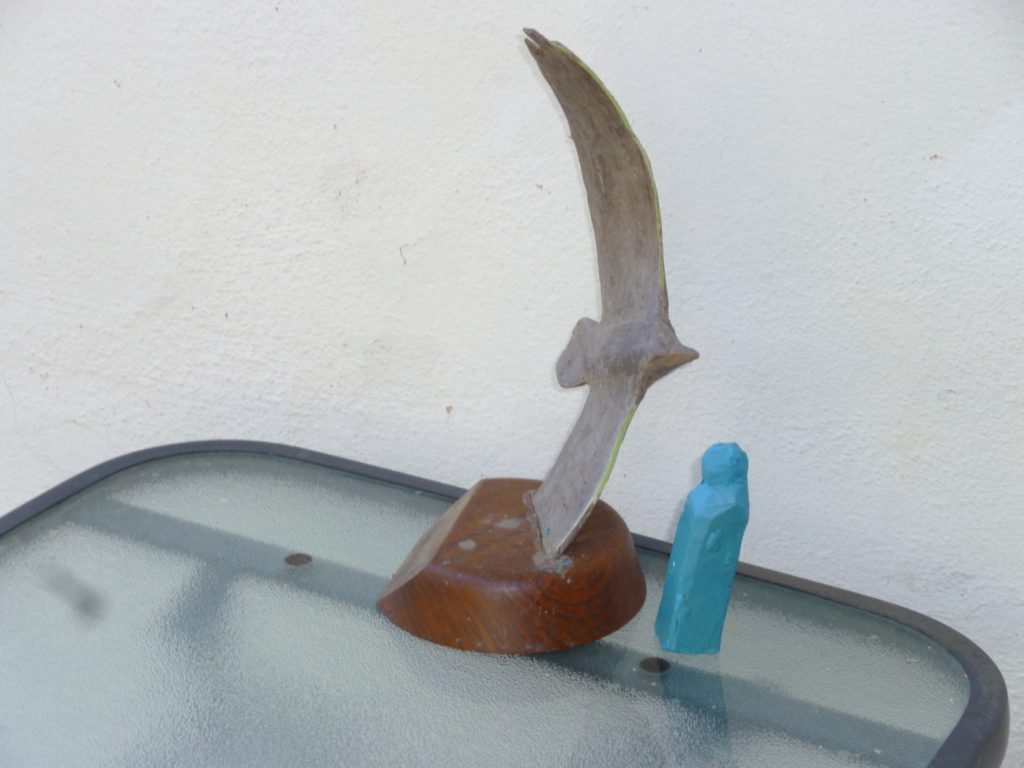
A Crazy Sale
It’s just for one day, but the craziest sale ever will take place on Saturday, February 24, at the new Magic Castle Cabaret parking lot, 30 Los Patos Way (in Baja Montecito).
We are cleaning out our warehouse, filled as it is with “trash and treasures,” and all the money raised will go to The Bucket Brigade helping Montecito families clean up after the mudslide.
Included in the sale are restaurant chairs, new wallpaper, tiles, antique light fixtures, fly fans, furniture, costumes, T-shirts, tote bags, posters, books, games, props, framed photos, paintings, massage table, antique tin panels, shop tools, and even a skeleton. People may also get a chance to peek in the door of the Magic Castle Cabaret to see how beautiful it will be.
No early birds, please!
Milt and Arlene Larsen
Santa Barbara
(Editor’s note: Milt is the founder of L.A.’s Magic Castle and lived on the beach in Montecito for nearly 15 years, though he and Arlene decamped to a home near TV hill that sports a similarly expansive ocean view to one they had in Montecito a decade ago. Arlene is a costume designer of the first order. This sale promises to be an event you’ll not want to miss! – J.B.)
Mud be Gone
There are many homeowners struggling to clean out the mud from their houses and property, while at the same time fighting with the insurance companies to be covered. Many could be limited to an amount that might not cover the cost of cleanup.
The biggest issue: where to put the mud and debris. A quick drive through the Montecito Oaks neighborhood (off Olive Mill and North Jameson) makes it very clear very fast that we have a big problem. It seems to me that our elected officials and public agency officials could be doing more to organize help in the neighborhoods to provide trucks or dumpsters for the residents to dump and haul the mud and debris.
Various agencies were able to coordinate this for the roads and other public areas before homeowners were allowed back into their houses to clean up. It seems that could be continued for at least a limited time to help out these neighborhoods that are devastated. As I have been talking to the people affected, I am hearing bids as high as $600,000 to have the dirt removed from a lot. If we can give citizens in need programs such as food stamps and cell phones to help make their lives better and give them a boost up, why can’t we give the residents, who pay a great deal in property taxes, some assistance? These people are part of our community, and I think most in our community would support this. If something as wonderful as the Bucket Brigade can be implemented, can we not then expect our public officials to make this happen?
Furthermore, there is a new problem that I have seen first-hand. Homeowners will clean up their lot or a portion of their lot, and when they are not there, someone else dumps debris on the area that has already been cleaned. I have been told of cases where creeks and/or debris basins are being cleaned out and the debris is being put on the properties, making it the homeowners’ problem.
Finally, the dirt that people are piling up into huge mounds can be creating a danger. People simply cannot afford to dispose of the dirt; therefore, the piles get bigger and bigger. In the event of a heavy rain event, these giant piles of mud could turn back into mud flows yet again, directly above the 101 freeway.
Please let our elected officials know that you would support them in this effort and get some help to our neighbors!
Don Gragg
Santa Barbara
Voters in Peril
In my view, there is an effort to corrupt America’s voting system for good. In L.A., the voting is 144 percent of all voters; in San Diego, it is about 138 percent. People are getting registered to vote when they obtain a driver’s license, which in no way legally qualifies anyone, of course (to vote).
Many say that [Barack] Obama is quietly signing up illegals to vote across the nation, and with [George] Soros money many small elections and the judiciary are being won by Democrats.
America could well be at a “permanent crossroads” with regards to the integrity of our going system.
Morten Wengler
Malibu/Montecito
(Editor’s note: We have no way of knowing if your statistics are accurate, but we do know that many localities report voting in excess of the numbers of voters in an area. That one party feels this is “nothing to worry about” is worrisome. – J.B.)
The New Math
For the second week in a row, Bob Hazard gives credit to Caltrans for opening the 101 in “three days” following the debris flow. Perhaps this is new math or something, but the 101 was closed on January 9 and reopened on January 21. In my book, that is 13 days. Admittedly, it was a monumental task and they deserve credit for it. But we should stick to the facts.
Art Thomas
Santa Barbara
(Editor’s note: Our opinion is that credit for the swift re-opening of 101 belongs to the U.S. Army Corps of Engineers, which, once they arrived, made things happen quicker than anyone would have thought possible. Also, we incorrectly printed the wrong version of Mr. Hazard’s guest editorial and we apologize for that – his final version had addressed those inaccuracies, but we failed to correct those in print. – J.B.)
We Wished So Hard for Water
We wished so hard for water
Ached for wetness long denied
But instead of kindly water
Flames burned the mountainside.
Hot and bleached and barren
Just scars and ash remain
In innocence we waited
Waited for the rain.
In early dark of morning
The long-awaited came
Instead of blessed showers
Devastation was its name.
A mighty torrent was unleashed
The trees were shucked like corn
The roots turned upwards in the flow
The houses ripped and torn.
The rocks began to roll then
The creeks began to flow
And there was mud, mud, mud
On everything below.
Mud fingers probed the neighborhood
Mud fingers broke through doors
It took the lives of many
And took the hopes of scores
Beside the broken houses
Crushed cars were thrown aside
And furniture, loved photographs
All took that fateful ride.
Gone the special keepsakes
The treasures people save
All went down together
In the muddy grave.
But we are Montecito
We’ll dig, rebuild, restore.
Again the trees and gardens
Will grace our streets once more.
– Sherry Bevan
Thought maybe you would be interested in printing this wonderful poem from my friend Sherry Bevan.
Jean von Wittenburg
Montecito
Mailing it out
Since late November 2017, Santa Barbara has been under an acute situation of mail theft that plagues Montecito, Hope Ranch, Santa Barbara, some in Goleta, the mountain communities of Painted Cave, West Camino Cielo, Rosario Park, Paradise Road, Kinevan, Stage Coach Road, San Marcos Pass, and possibly Lompoc and/or North County.
The mail theft holiday and disaster opportunistic “trend” has gone beyond such “time periods,” and given that Montecito remains in a cautionary state, residents are vulnerable to mail theft and the mountain community as well, being the chosen “rural” “dumping area.” The perpetrators vary, with the possibility that there may be repeat offenders to certain neighborhoods.
What is being done?
How are people being notified of their mail being compromised (i.e., outgoing mortgage checks taken but thrown into the bushes, not reaching their destinations)? For instance, how much do the Montecito residents know of this mail theft? Has the inspector been in contact with their local post offices?
Aside from surveillance cameras, motion-detector lights, locking mailboxes (of which many can be busted or an implement stretched through mail slot to retrieve contents), we need a community-coordinated residential crime alert system like OEM has for environmental disasters.
Concerned Residents of Santa Barbara County
(Editor’s note: A version of this letter was sent to USPS inspector Clinton Barry and Congressman Salud Carbajal; for the record, we have not recorded an uptick in this kind of crime in Montecito, though the large array of mailboxes on Mountain Drive have, over the years, been a frequent target. – J.B.)
The 2011 Norway Massacre
On July 22, 2011, a massacre occurred at a summer camp on the island of Utoya in Tyrifjorden, Buskerud, Norway. The camp was organized by the AUF, the youth division of the ruling Norwegian Labor Party (AP). The 39-year-old attacker, dressed in a homemade police uniform and showing false identification, took a ferry to the island and opened fire at the participants, killing 68 of them outright, and injuring at least 110 people, 55 of them seriously. The 69th victim died in a hospital two days after the massacre. Among the dead were personal friends of prime minister Jens Stoltenberg, and the stepbrother of Norway’s crown princess Mette-Marit.
It was the deadliest attack in Norway since WWII and a survey found that one in four Norwegians knew “someone affected by the attacks.” The European Union, NATO, and several countries around the world expressed their support for Norway and condemned the attacks. On August 13, 2012, Norway’s prime minister received the Gjory Report, which concluded that Norway’s police could have caught the gunman faster at Utøya, that more security was necessary, and recommended that emergency measures to prevent further attacks and “mitigate adverse effects” should be implemented.
Is it scientifically, or politically, possible to prevent very bad things from happening?
Dale Lowdermilk
Santa Barbara
(Editor’s note: In the bad old days, the first thing people would consider would be preventive measures such as increased security, armed guards, limited surveillance, possible intervention, and the like; today, however, dis-arming those who may be in a position to prevent a recurrence seems to be the response. “If you see something, say something,” was apparently just a PR ploy and no one involved or in charge had any intention of taking action. – J.B.)
Savor the Spirit
The whole world is watching Pyeongchang. The Olympic games are a powerful symbol of international cooperation and goodwill, while the spirit of the games represents the possibility of peace and progress in our time. Hope like that, especially on the Korean peninsula, is something sorely needed in these dark times.
Despite the clear possibility for shared progress toward peace, President Trump and his administration seem to be doing all they can to stifle it. From disparaging other nations as s**t holes, to spurning international agreements, to seeking to make nuclear war easier to wage, Trump has done all he can to trample on the international goodwill. In short, Donald Trump and his team are the antithesis of the Olympic spirit.
As disheartening as outbursts from the president are, it is within our power to reverse the damage he has done; Congress has a wealth of options to do just that. I am calling on our members of Congress to demand the administration focus on diplomacy rather than military bluster, to oppose the nuclear agenda set forth by Trump at every dangerous turn, and to censure his derogatory rhetoric. Perhaps if we learned from the Olympic Spirit rather than spat on it, we would find ourselves in a much less scary world.
Carol Shabrami
Santa Barbara
Good Intentions All
Thank you for all your good and generous intentions in keeping our community together. I live in Montecito on Danielson Road off the Olive Mill overpass. My daughter, myself, and my pet were among the lucky and the blessed.
A few years ago, you published a Christmas Limerick I wrote, saying you saw it as written with good intention. This is nothing like a limerick. But it is written with nothing but good intentions.
after
seekers and finders all
of art, of music
of design
…hope
to seek the best
to be the best
to find the best
in all we are
to give
our only heart
to the ones
we love most
mothers and fathers
sons and daughters
brothers and sisters
friends and beloved
there are no distinctions
not now
not in these days
of who we are
but for who
we are to each other
when one loses
all of us lose
our place
we falter
in our steps
to regain our loss
as we reach
for the outstretched
hand of strangers
who find us
in what we knew
as life
they carry us
when all is lost
they strengthen us
to remember
why we are here
the seekers
and finders
a place of beauty
to steal
your breath and capture
your soul
we the dreamers
know
what the seekers
want to find
to somehow
make whole again
the place that left us
we will not leave
calmer now
we are kinder
we are quiet
and see the disparity
that is
or is not ours directly
helpless in this change
we are more real
Sharon Bellandi
Montecito
Where’s the Shame?
This takes the icing on the cake. A lot of us in Montecito suffered great loss and tragedy. In the midst of this horror, a bakery on Coast Village Road is taking advantage of this misery and is asking for donations on gofundme.com. Without an ounce of humility, their post on the Internet is aiming pretty high, at $60,000. None of their locations have suffered any material damages, and a good part of the money will be used to expand their business, pay the rents (we assume their own home too) and buy… a delivery van!
We find this offensive and very sad, as many residents have lost family members, friends, and homes were destroyed. Many of us had to scramble, leave in a hurry with only the clothes on our back. We grabbed kids, pets, leaving behind years of memories and precious items.
But, we have our pride.
Sorry, No Name
A Montecito Resident
Changes Required
We appreciate the Montecito Journal. It is a weekly “must read.” The Journal has been a valuable information source for the recent fire and flood.
We need a change in wildfire management.
What follows is a communication on that subject that we have emailed to our elected officials including the SB County supervisors, City of SB mayor and council, U.S. representative Salud Carbajal, U.S. Senators Kamala Harris and Dianne Feinstein, State Assembly member Monique Limon, and State Senator Hannah-Beth Jackson. Together, those elected officials and we citizens can influence how wildfires are managed in this future.
California suffered unprecedented wildfires in 2017, with 32,000 homes damaged or destroyed and $12 billion in insured loss, per California insurance commissioner Dave Jones. This does not include costs of fighting fires, mitigating flood damage, or the loss of lives, property, or damage to business (including tax loss) or quality of life, including environmental.
The fires in Santa Barbara, Napa, and Sonoma counties are especially notable. As an example, and local to us, the Thomas Fire (California’s largest at 280,000 acres, costing ($170 million in firefighting costs) was followed by the huge flood in the Montecito area in January 2018; the losses are huge, including 21 deaths and over 460 homes damaged or destroyed. We recall that Highway 101 was closed for nearly two weeks. Air quality was horrible in Santa Barbara and elsewhere during the Thomas Fire.
It is time for a change in policies and practices to reduce the severity and size of these fires. The amount of fuel (brush, trees) needs to be reduced so unexpected fires can be put out much faster. There should be no debate that fires need fuel to burn; if there is no fuel, there is no fire; if there is little fuel, there will be little fire.
It appears appropriate to return to controlled burns and other strategies.
Can you initiate action to change policy and practice so horribly destructive fires are significantly reduced?
The cost of a new effective wildfire management program could be less than the government and private costs of remediating the damage from fires as they currently occur. Current environmental policies are meaningless when confronted with the huge pollution of wildfires.
A recent summary of returning to prior successful wildfire and flood management practices was discussed by Ron Fink writing in Noozhawk on January 23:
“Generally, there are two ways to manage fuel beds: mechanical manipulation and controlled burning. Fuel clearance operations are needed to reduce the fuel load and offer strategic control points in the event an unplanned fire occurs.
“These so-called fire breaks are effective, and fires can be contained to much smaller areas where they exist.
“Environmental activists claim such operations ‘damage the environment and/or habitat’ and claim we should let fire take its natural course.
“The recent, uncontrolled Thomas Fire, ‘damaged’ more than a quarter of a million acres of the habitat they are trying to save; so, which is better, losing a few hundred acres to fuel load reduction or the damage we witnessed in December?
“There are also two ways to manage storm water flow during heavy rains: maintaining the fuel beds and drainage improvement.
“Once again, environmental activists claim such operations ‘damage the environment and/or habitat’ and claim we should let nature take its natural course.
“Nature took its course and a sizeable portion of an affluent community was wrecked, and some of the homes of folks who fund the environmental activists’ community were lost.
“So, which is better, losing a few hundred acres to storm water flow management, or the inevitable devastation we witnessed this month?”
We look forward to learning of your plans to be able to reduce the size, duration, and impact of wildfires and would be happy to discuss this with you. We believe past successful practices should be strongly considered and they will be found to have significant cost and environmental benefit.
Sincerely,
Garth and Kathy Nobis
Santa Barbara
(Editor’s note: Of course, we should re-institute controlled burns and creek-clearing activities. We sincerely hope the “environmental community” can now see the wisdom in those age-old practices. Every year for the past decade, those of us who live here would dread the upcoming “fire season,” as we pondered the stored energy of “six or seven Hiroshima-sized atom bombs” waiting to explode in the hills just behind Montecito that hadn’t burned for 40 years or more. That firebomb finally went off in December, and we were relieved when the fire seemed to have been finally contained… for a few days, until the horrific events of January 9. Our advice is to put the U.S. Army Corps of Engineers to work full time on creek-clearing and setting up a controlled burn system local authorities could follow, and while they are at it [we are only half-kidding here] to take charge of the widening of 101 through Montecito. – J.B.)
Help from Habitat
Twice I responded to a request from Habitat for Humanity for help clearing mud in the Montecito Oaks development. The first time, 75 volunteers showed up and worked on seven homes. It was truly a community effort, the Red Cross delivered lunches for all of us and Direct Relief donated safety gear. A neighbor from across the street from where my group was shoveling mud was out working right along beside us. She had rented a Bobcat with an operator and offered to clear the driveway and part of the yard for us, then had the machine move on to another property. This inspiring woman’s home and yard were undamaged.
Members of the Santa Barbara Bucket Brigade were also out clearing properties. The area has memories for me that I never wrote about for my “Montecito Scrapbook” column in the Montecito Journal. Sixty-five houses were built on the property my mother remembered being the Miramar Dairy, for the hotel. My older brother just told me about beef cattle pastured there, and that he and his friends went in and threw dried “cow patties” around. I recall horses running in the big pasture when I was about seven or so.
When the property was starting the present development, in 1953, I had just been given a horse. My friend Pam Ballard and I rode every morning before school and our favorite racetrack was on the wide dirt roads carved out and graded on the old dairy land.
Three model houses were on Olive Mill Road. They were completely furnished, one in Early American Maple, another in Danish Modern, and the third was traditional with mahogany furniture. There was a full-page ad in the News-Press offering the houses to be built for $24,000. My friend Susie Hammond and I liked to go into the homes and pretend we lived there, picking out a favorite bedroom and making ourselves comfortable on the beds. It amazes me now to wonder why the realtors showing the places didn’t just kick us out; we were, after all, only 12 years old.
In the beautiful neighborhood of Montecito Oaks that I remember, it was disturbing to see the heartbreaking destruction from the mudslide. However, optimism rose up in me to see the community pitch in to help make Montecito whole again.
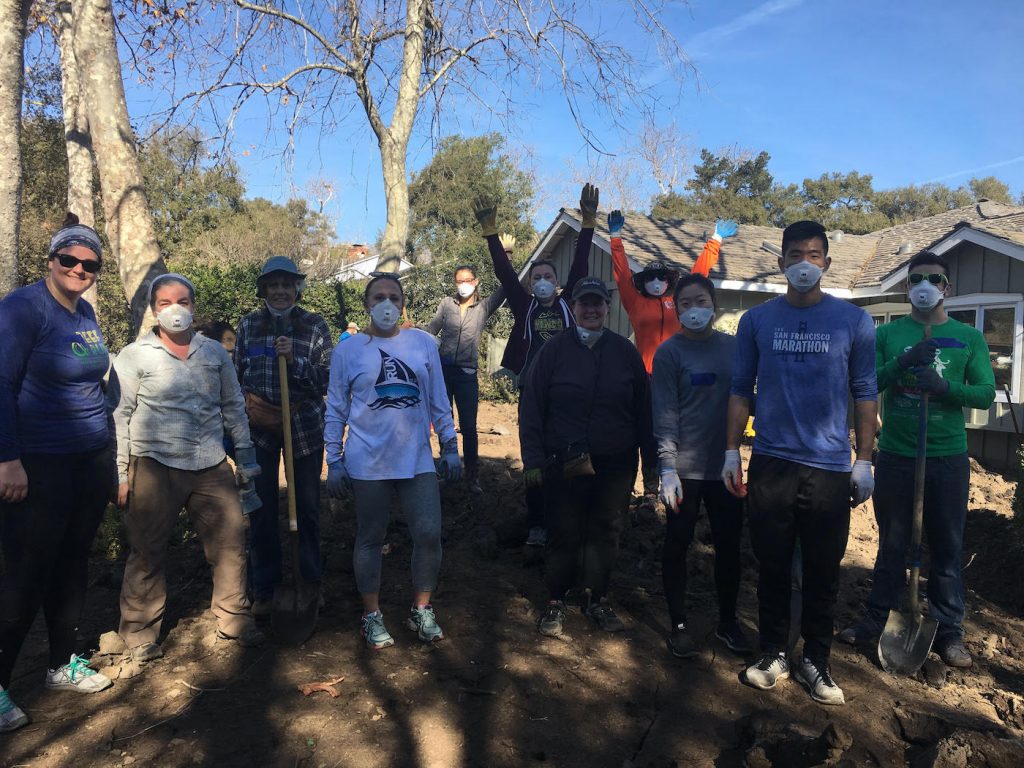
On February 10, I volunteered with Habitat for Humanity to help homeowners in Montecito Oaks. Habitat for Humanity’s Rose Levy handles the monumental task of organizing volunteers who respond to her plea for assistance and making arrangements for all the details involved to be sure we are safe, have plenty of tools to work with, and are well taken care of; she had crews out on February 7, 10, and 11.
That day, 198 volunteers included employees from Home Depot who were not only local residents but came from Simi Valley to Atascadero to pitch in. Groups of volunteers from several churches were also involved. Lunch was provided to all by the Salvation Army, and once again, Direct Relief distributed safety gear. Hard-working and gracious homeowners who repeatedly thanked us made our efforts especially rewarding.
Two young boys whose home is on Santa Isabel Lane worked alongside us in their yard while giving a first-person explanation about what the experience was like to have mud and debris roaring up to their home in the wee hours of January 9. One told us, “We thought we’d be able to leave until we saw our mother’s car wash away. The firemen had to walk us out.”
The people I’ve met who were heavily impacted by the storm have impressed me with their resilience in moving on a path back to normality. (The “free food” table was out again this week.)
Judy Pearce
Carpinteria
(Editor’s note: Ms Pearce wrote a regular history column for Montecito Journal from 1996 to 2001 or so; she has also written extensively for Montecito magazine. – J.B.)
The Casa Stands
After the mudslides, walking in the Casa gardens was surreal. Flowers burst with color in the cutting garden, roses bloomed in the rose garden, and the orchards were full of ripe citrus fruit. Birds chirped in the distance.
It was stunning, just a few blocks away from tragedy, to be surrounded by such beauty. It was healing and comforting to know the Casa del Herrero had weathered the storm.
For some people, life continues as it did before. But for others, life will never be the same. I am heartened by Montecito’s resiliency, how quickly the community has come together to rise about the tragedy, to try to become whole again. I am amazed at the great work of the first responders, firefighters, police officers, and individuals working to bring our community back.
Many of you have expressed concern about the Casa, and I want to thank you for keeping the estate in your hearts. Your passion and love lifts us. And, it’s your support that keeps us going. Thank you for being there.
Jessica Tade
Montecito
(Ms Tade is executive director of Casa del Herrero.)
It Will Happen Again
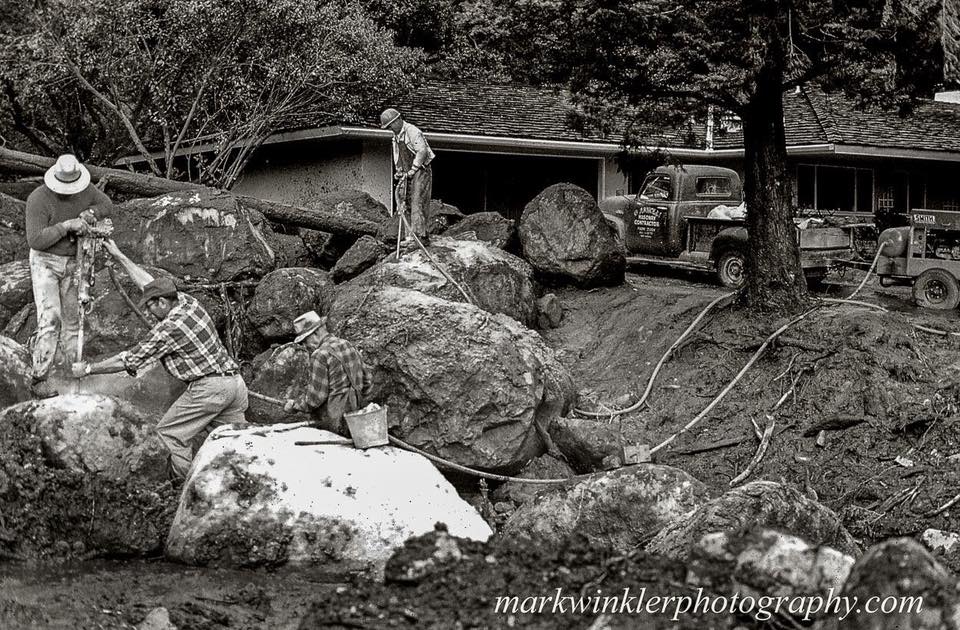
There is a long documented history in Montecito of what happened in January 2016. Seems the county office of emergency management did not do sufficient research. If they had used all these old photos to show the public in the media press conferences, it would have made a far bigger impression on the public as to the danger.
During the big rains of January 1969, a river of mud came down Olive Mill Road and, in addition to covering Coast Village Road’s paved roadway, rushing water flooded the basement of the Montecito Inn, where some valuable collectors’ cars were stored.
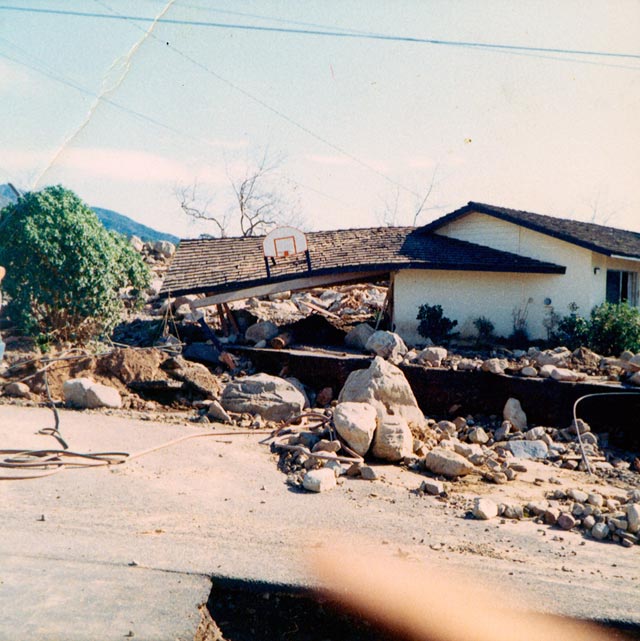
In January 1969, California saw a series of storms that brought 10 continuous days of rain to the southland. Locally, the storms were most severe in Montecito and Carpinteria. The events from the 1969 winter storms can serve as a cautionary tale.
On January 18, 1969, the first of two five-day storms made landfall along the coast of California. The rain for Santa Barbara that day was around 1 to 2 inches. The county to date had seen a only modest amount of rain for the year. The next day, however, the rain started coming down heavier, bringing with it flash floods and the first tragedy associated with the storms.
On Sunday afternoon, January 19, seven teenage boys decided to test out their homemade raft on rain-swollen Arroyo Burro Creek near La Cumbre Plaza. The boys put in near the YMCA, where strong currents grabbed the raft. Four of the boys jumped off, while the other three were swept downstream toward the 426-foot long cement tunnel that carries the creek under Calle Real, the railroad tracks, and Modoc Road. Two of the boys were able to make it ashore and call out for help, while the third, Mark Williams, was carried through the tunnel and drowned.
Members of Los Padres Search and Rescue Team arrived on the scene and two of them entered the tunnel, one from each end, in an effort to find Williams. They met midway on separate catwalks. When team member Don Buck attempted to jump across to the other catwalk he was swept away in the rising water, pulling in Rick Mohun, who was holding the safety line attached to Buck. Two more team members, Denis Huestis and Donald Thompson, tried to help and all four were swept downstream through the tunnel. Buck was pulled out but failed to respond to resuscitation. Mohun and Thompson made it out safely, but Huestis drowned.
The rains were also rapidly filling our local reservoirs. On January 20, Gibraltar Reservoir was the first to overflow, having risen 15 feet the day before. The next morning, Jameson Reservoir, having risen 20 feet the previous day, overflowed.
On January 23, there was a lull in the weather as the first storm played out. The county saw modest rainfall that day and some clearing skies, but more rain was on its way. The next day, the second five-day storm system hit an already saturated California, compounding the flood damage from the previous storm.
Carpinteria was hit the hardest. During the first storm, 39 families had been forced to evacuate. When the second storm hit all three major creeks, Santa Monica, Franklin, and Carpinteria Creeks, overflowed, flooding much of the town and leaving behind silt-laden water, mud, and debris. One thousand of the 7,000 people living in Carpinteria were evacuated.
Many of the creeks originating in the Santa Ynez Mountains overflowed, causing flood damage to the nearby neighborhoods. Heavy rains loosened boulders weighing as much as 30 tons, that then rolled down the canyons, clearing everything in their path and creating debris that would then jam up at various bridges. San Ysidro Creek, for example, backed up at the East Valley Road bridge, sending water into the adjoining neighborhoods.
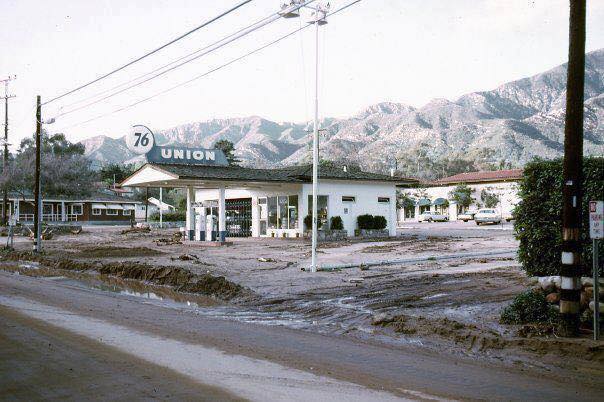
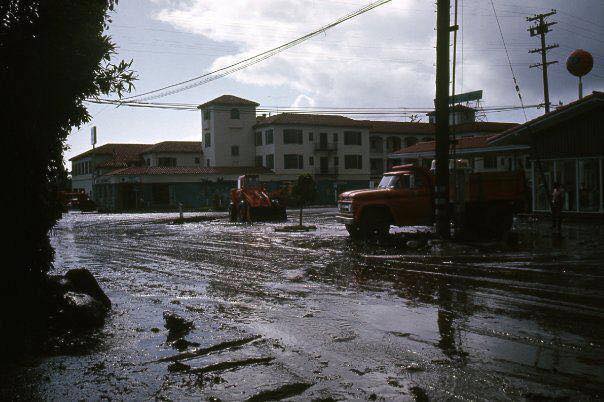
On January 25, Governor Reagan declared the County a disaster area as more rain continued to fall. The next day, the Santa Barbara News-Press headline read “Wettest January Since 1916 Douses Santa Barbara County”. The January rainfall total was surpassed only by the 1995 storms.
The record, however, for the most amount of rain in a 24-hour period still belongs to 1969. On January 26, Jameson Lake recorded 16.31 inches of rain. The heavy rain, however, brought with it more tragedy. The already overflowing reservoir washed out the caretaker’s cabin below the dam killing the caretaker, William Brooks.

The raging waters also fueled unfounded rumors that Gibraltar Dam was going to break under the strain of more water flowing through its spillway than it was designed to handle.
Farther downstream along the Santa Ynez River, residents along Paradise Road trying to evacuate from the rising waters were cut off when the bridge across Los Laureles Creek was washed out. One-hundred twenty residents were then airlifted out by helicopter.
Those same rising waters caused Lake Cachuma to overflow on January 25. When the floodgates were opened, the river grew to a 600-foot wide torrent, flooding various parts of the valley. In Lompoc, the sewage treatment plant located next to the river was flooded, along with 4,000 acres of farmland.
Then, on January 28, just as the rain was starting to play out, Santa Barbara was struck by a second disaster. The blowout at Platform A occurred, which released 80,000 to 100,000 barrels of oil over the next several months into the Santa Barbara Channel. It was the worst oil spill at that time and helped lay the foundations for the modern environmental movement.
February brought still more rain and flooding; however, by comparison the damage wasn’t as bad in Santa Barbara County. Ventura County, which also saw major flooding during January, was hit harder by the February rains. On February 25, around 2:30 am, one of the levees along the Santa Clara River gave way. The river changed course and flowed out through the Ventura Marina. Three-hundred boats were damaged or completely destroyed. No lives were lost, and a number of boats were spared by being in dry dock to avoid damage from the oil spill. According to engineers on site, if the rain and erosion had continued, the river would have likely returned to its ancient course through downtown Oxnard.
There are many lessons from these years of heavy rains and flooding, and it is a testament to the work of our first responders and city planners that those lessons have been integrated into our disaster preparedness programs. That awareness has, in turn, helped to reduce the overall impact of subsequent storms and the damage they can create.
Until January 9, 2018 happened, that is.
There now also has to be a look at where and how building permits are issued In Montecito. An incident like this can happen again. Within the next five years are a possibility and even anytime in the future.
If what happened 50 years ago could be repeated in 2018, it seems no lessons were learned.
Nigel Gallimore
Montecito
(Editor’s note: The rains of January and February 1996 also caused flooding along Olive Mill Road, though sandbags were able to protect most of the homes, as no mudslide accompanied the water. However, Highway 101 was flooded and closed, and residents living near Salinas and the new “sound wall” built by Caltrans in connection with the removal of the traffic lights a couple years earlier, utilized axes and hammers to break through and allow the floodwaters to pass onto the highway rather than into their homes. – J.B.)







You must be logged in to post a comment.